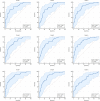Biomarker combinations in predicting sepsis in hospitalized children with fever
- PMID: 35550043
- PMCID: PMC9097178
- DOI: 10.1186/s12887-022-03285-3
Biomarker combinations in predicting sepsis in hospitalized children with fever
Abstract
Sepsis is among the leading causes of critical illness worldwide. It includes physiologic, pathologic, and biochemical abnormalities, induced by infection. Novel methods for recognizing a dysregulated inflammatory response and predicting associated mortality must be developed. Our aim was to investigate biomarkers that characterize a pro-inflammatory and anti-inflammatory response in patients with fever by comparing predictive validity for sepsis. 165 patients with fever were enrolled in this study, 55 of them had sepsis according to pSOFA criteria. All patients had blood samples drawn at the time of inclusion and after 24 h. CRP, PCT and also IL-6, IL-8 and sFAS levels were significantly higher in patients with sepsis. The AUC of CRP to predict sepsis was 0.799, all the other biomarkers had AUC's lower than that. Cytokines, when used as a single marker, did not show a significant diagnostic performance We analyzed various models of biomarker combinations. CRP combined with sFAS showed increase in sensitivity in predicting sepsis (88% vs. 83%). The highest AUC was achieved, when CRP, IL-6, sFAS and sVCAM-1 markers were combined 0.830 (95% CI 0.762-0.884) with a sensitivity of 70% and specificity of 84%. vs. 0.799 for CRP alone.
Keywords: Biomarker; Cytokine; Fever; Pediatric; Sepsis.
© 2022. The Author(s).
Conflict of interest statement
The authors declare that they have no competing interests.
Figures
References
-
- Goldstein B, Giroir B, Randolph A. International pediatric sepsis consensus conference: Definitions for sepsis and organ dysfunction in pediatrics. Pediatr Crit Care Med. 2005;6. 10.1097/01.PCC.0000149131.72248.E6. - PubMed
Publication types
MeSH terms
Substances
LinkOut - more resources
Full Text Sources
Medical
Research Materials
Miscellaneous




